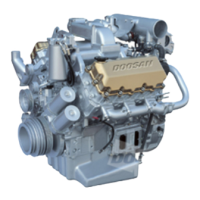
 Loading...
Loading...
Do you have a question about the Doosan DV11 and is the answer not in the manual?
| Engine Model | DV11 |
|---|---|
| Number of Cylinders | 6 |
| Bore x Stroke | 123 mm x 155 mm |
| Compression Ratio | 17.0:1 |
| Fuel System | Common Rail |
| Fuel Type | Diesel |
| Emissions Compliance | Tier 4 Final / Stage IV |
| Total Displacement | 10.96 L |
| Aspiration | Turbocharged, Intercooled |
| Engine Type | 4-cycle, water-cooled, diesel engine |
General safety notes, preventing injury, and environmental damage.
Information about the SCAN-200 tool for diagnosis and repair.
Troubleshooting guide for common engine faults and their solutions.
Guidelines for routine engine inspections and part usage.
General precautions and steps for disassembling the engine.
Procedures for measuring and inspecting critical engine parts.
Step-by-step instructions for reassembling engine components.
Overview of the common rail fuel injection system and its components.
Engine fault codes, diagnostic methods, and ECU operation.